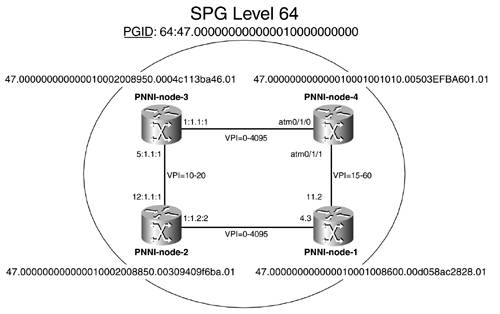Cisco IOS Software-Based PNNI Node
| For completeness, we include in the picture a Cisco IOS Software-based PNNI node. The PNNI configuration is shown in Example 10-30, following our address scheme. Example 10-30. PNNI Configuration in Cisco IOSLS-1010#conf t Enter configuration commands, one per line. End with CNTL/Z. LS-1010(config)#atm address 47.000000000000010001001010.00503EFBA601.01 LS-1010(config)#no atm address 47.0091.8100.0000.0050.3efb.a601.0050.3efb.a601.00 LS-1010(config)#atm router pnni LS-1010(config-atm-router)#node 1 disable LS-1010(config-pnni-node)#node 1 level 64 lowest LS-1010(config-pnni-node)#node 1 enable LS-1010(config-pnni-node)#^Z LS-1010#show atm pnni local-node PNNI node 1 is enabled and running Node name: LS-1010 System address 47.000000000000010001001010.00503EFBA601.01 Node ID 64:160:47.000000000000010001001010.00503EFBA601.00 Peer group ID 64:47.0000.0000.0000.0100.0000.0000 Level 64, Priority 0 0, No. of interfaces 1, No. of neighbors 0 ... Cisco IOS Software-based PNNI node interfaces have autoconfiguration set by default. No more configurations are needed on this side as long as ILMI is configured on the links. ILMI is used for link signaling and parameter negotiation. To complete your PNNI network setup and form a square, you configure two pnports: port 11.2 using VPI range 15 to 60 in the BPX-SES, and port 1:1.1:1 using VPI range 0 to 4095 in the MGX-8950. Both pnports go toward the Cisco IOS Software PNNI node, and the configuration is exactly as you did before. ILMI and PNNI should be up. VSI ILMI configuration in the BXM and AXSM slaves should be set. The current PNNI network topology is shown in Figure 10-7. Figure 10-7. PNNI Network
To display the details of your PNNI network, display the PNNI database from the LS1010 using the command show atm pnni database (equivalent to the command dsppnni-idb in BPX-SES and MGX PNNI nodes). See Example 10-31. Example 10-31. Using show atm pnni database LS-1010#show atm pnni database Node 1 ID 64:160:47.000000000000010001001010.00503EFBA601.00 (name: LS-1010) PTSE ID Length Type Seq no. Checksum Lifetime Description 1 144 97 5 62436 2503 Nodal info 2 52 224 6 56669 2490 Int. Reachable Address 3 124 288 2 22664 2620 Horizontal Link Node 9 ID 64:160:47.000000000000010001008600.00D058AC2828.01 (name: SES-3a) PTSE ID Length Type Seq no. Checksum Lifetime Description 1 148 97 22 24725 2725 Nodal info 12 52 224 39 7983 3462 Int. Reachable Address 13 220 288 3 13020 2725 Horizontal Link 16 220 288 1 33604 3480 Horizontal Link Node 10 ID 64:160:47.000000000000010002008850.00309409F6BA.01 (name: m8850-7a) PTSE ID Length Type Seq no. Checksum Lifetime Description 1 152 97 108 43988 2644 Nodal info 8 52 224 38 31703 3001 Int. Reachable Address 11 220 288 3 13681 2759 Horizontal Link 13 220 288 2 18578 3070 Horizontal Link Node 11 ID 64:160:47.000000000000010002008950.0004C113BA46.01 (name: m8950-7b) PTSE ID Length Type Seq no. Checksum Lifetime Description 1 152 97 107 49822 3105 Nodal info 8 52 224 4 4360 3104 Int. Reachable Address 9 220 288 2 18653 3105 Horizontal Link LS-1010# You can see the PNNI neighbors and the links between them, as shown in Example 10-32. Example 10-32. Displaying PNNI NeighborsLS-1010#show atm pnni neighbor Neighbors For Node (Index 1, Level 64) Neighbor Name: SES-3a, Node number: 9 Neighbor Node Id: 64:160:47.000000000000010001008600.00D058AC2828.01 Neighboring Peer State: Full Link Selection For CBR : minimize blocking of future calls Link Selection For VBR-RT : minimize blocking of future calls Link Selection For VBR-NRT: minimize blocking of future calls Link Selection For ABR : balance load Link Selection For UBR : balance load Port Remote Port Id Hello state ATM0/1/1 11.2 2way_in (Flood Port) Neighbor Name: m8950-7b, Node number: 11 Neighbor Node Id: 64:160:47.000000000000010002008950.0004C113BA46.01 Neighboring Peer State: Full Link Selection For CBR : minimize blocking of future calls Link Selection For VBR-RT : minimize blocking of future calls Link Selection For VBR-NRT: minimize blocking of future calls Link Selection For ABR : balance load Link Selection For UBR : balance load Port Remote Port Id Hello state ATM0/1/0 1.1 2way_in (Flood Port) LS-1010# The links are in twoWayInside state. You can see topology details for a specific PNNI node in the database using the command show atm pnni topology as shown in Example 10-33. Example 10-33. Displaying PNNI Topology Details LS-1010#show atm pnni topology node 11 Node 11 (name: m8950-7b, type: bpx/mgx, ios-version: 0.0) Node ID..: 64:160:47.000000000000010002008950.0004C113BA46.01 Node AESA: 47.000000000000010002008950.0004C113BA46.01 Leadership Priority: 0, Claims PGL: No, Transit Calls: Allowed Ancestor: No, Nodal Representation: Simple, Connected: Yes More P2MP Branch Points: No, Non-Transit For PGL Election: No Advertises ONHLs: No status link type local port remote port neighbor ~~~~~~ ~~~~~~~~~ ~~~~~~~~~~~~~ ~~~~~~~~~~~~~ ~~~~~~~~ up hrz 5.1 12.1 m8850-7a up hrz 1.1 ATM0/1/0 LS-1010 LS-1010# |
EAN: 2147483647
Pages: 149
